Editing the Current Color Table - OCLO
- 01- CAVE Fundamentals
- Setting the Time Match Basis of a Product
- Loading and Toggling Radar Graphic Overlay Products
- Overlaying CAPE on a Base Reflectivity Product
- Overlaying a Surface Plot on a Base Reflectivity Product
- Overlaying Model Image on Radar and Satellite
- Transferring Screen Products Between the Main Display Pane and Side Panes
- Loading, Arranging, Renaming, and Unloading Additional Map Editors
- Zooming In or Out of a Product View
- Panning a Zoomed-In Image in the Main Display Panel
- Switching the Color Table for a Radar Image Product
- Editing the Current Color Table
- Unload a Map Overlay
- Loading a Map Overlay
- Changing a Map's Display Characteristics
- Loading the Alphanumeric Information for a VWP Product
- Using the AFOS Browser to Load an Area Forecast Discussion
- Move and Adjust Width of AlertViz
- Launch Text Section Log and Display Detailed View
- Loading and Using the AWIPS Data Monitor
- Blinking a Range of Data Values
- Printing the Contents of the Main Display Panel
- Creating a Screen Capture of the Main Display Panel
- Saving/Loading Editor and Perspective Displays
- 02- D2D Fundamentals
- Create a New Procedure
- Opening an Existing Procedure
- Load a Product from the Product Inventory
- Clearing a Product from the Main Display Panel
- Manually Toggling and Looping Single Elevation Angle Products in Time
- Create an Image Combination and Toggle Between the Images
- Use Panel Combo Rotate and All Panel Sample on Dual Pol
- 03- D2D Radar
- Load Radar Products for Single Radar and Radar/MRMS Mosaics
- Toggling Product Displays
- Viewing Radar Cursor Readout Information
- Loading Products into Four-Panel Displays
- Submit an OTR for a Three Hour Precip (THP) Product
- Build a New Request in the RMR GUI
- Managing Active Requests in the RMR GUI
- Loading an All Tilts Product into the Main Display Panel
- Load a VWP Hodograph
- Load a Vertical Reflectivity Cross-Section Image Product Using the Volume Browser
- Load a Horizontal Reflectivity Cross-Section Image Product Using the Volume Browser
- 04- D2D Satellite
- 05- D2D Upper Air
- Load NSHARP into your CAVE Display
- Change NSHARP Configurations
- Cycling Through the Tables
- Toggling Display Insets
- Toggling Graphs and Statistics
- Interact with the Inventory in the D2D Skewt Standard Screen Configuration and Use Keyboard Shortcuts
- Configuring a Sounding and Hodograph Display
- Changing the Parcel Lifting Method
- Display Multiple Active Soundings
- 06- D2D Tools
- 07- D2D Applications
- Issue A New Severe Thunderstorm Warning
- Follow Up a Severe Thunderstorm Warning with a Severe Weather Statement
- Loading an FFMP Basin Trend Graph and Downstream Basin Trace
- Assessing QPE, Ratio, and Diff
- Closing the FFMP Table
- Loading the FFMP Basin Table
- Loading a SCAN Storm Cells Table
- Interacting with the SCAN Storm Cells Table
- Launching the MESO and TVS Tables
- Closing the SCAN Cell Table
Purpose:
This task demonstrates how to make changes to the current color table using the Color Table Editor.Tasks:
Assumptions:
- You have an image product loaded in the main display panel.
- Load the Image Colors Editor using one of the following methods:
- Method 1: Position the cursor over the image product name in the product legend. Right-click and hold and select Edit Colors.
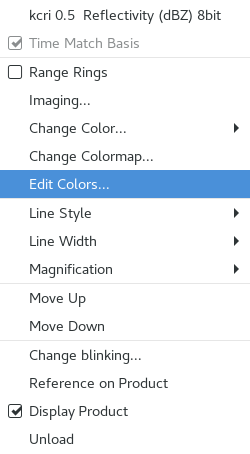
- Method 2: Open the Image Properties GUI using the keyboard shortcut <CTRL>+I.
- In the Image Properties GUI, select the “Edit [product_name]” button (where [product_name] is the product to which the color table is applied).
- Method 1: Position the cursor over the image product name in the product legend. Right-click and hold and select Edit Colors.
- Pick a range of values to edit by positioning half-arrows using one of the following methods:
- The arrow at the top should be at the lower end (i.e., left side) of the range, while the arrow at the bottom should be at the higher end (i.e., right side) of the range.
- The data values that correspond to the location of each half-arrow appear next to the arrow. Use this information when setting up your range of values.
- Method 1: Left-click on an arrow with your cursor and drag the arrow to the desired location in the color table scale. Repeat for the other half-arrow.
- Method 2: Utilize the directional buttons near the color table scale
- There are four buttons that control each arrow: “<”, “<<”, “>”, and “>>”.
- The “<” and “>” buttons move the arrows on small increments in each direction.
- The “<<” and “>>” buttons move the arrows in larger data ranges.
- The top two buttons on each side control the position of the top arrow while the bottom two buttons on each side control the position of the bottom arrow.
- Change the color in the upper or lower color panel using one of the following methods:
- Method 1: Choose the color model you want to use (e.g. RGB) and position the slider bar for each channel to create your desired color (the new color appears in the preview window in the upper right-hand side of the color panel). Then click the Set button.
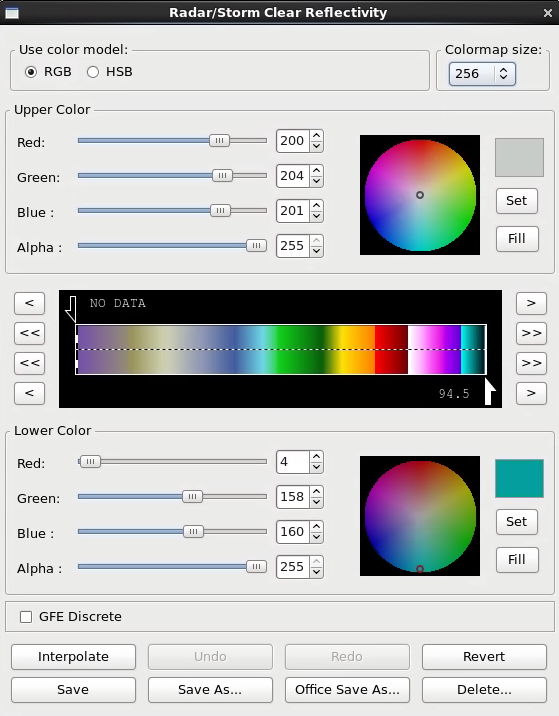
- Method 2: Locate the color marker (i.e., the gray double circle, or “bulls-eye”) in the color wheel, then left-click on it and drag it to the desired position on the color wheel. Then click on the Set button.

- You will only be able to change the Hue or Saturation values in HSB mode for a given color using this method. You will have to change the Brightness manually if you choose to change it.
- Method 1: Choose the color model you want to use (e.g. RGB) and position the slider bar for each channel to create your desired color (the new color appears in the preview window in the upper right-hand side of the color panel). Then click the Set button.
- Fill a range of values.
- Set the range of values using one of the methods in Step 2.
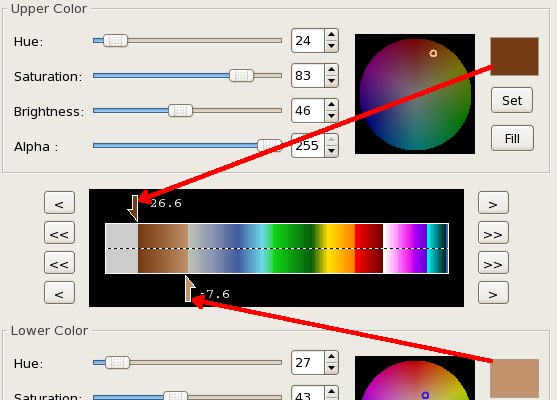
- Adjust the color(s) in the upper or lower color panel using one of the methods in Step 3.
- Left-click on the Fill button in the appropriate color panel.
- Set the range of values using one of the methods in Step 2.
- Interpolating a range of values between two colors.
- Set the range of values using one of the methods in Step 2.
- Adjust the colors in both the upper and lower control panels using one of the methods in Step 3.
- Left-click on the Interpolate button in the bottom button panel.
- Change the transparency of an image.
- Set the range of values to make transparent using one of the methods in Step 2.
- Slide the Alpha slider bar all the way to the left in both the upper and lower color panels (totally dark).
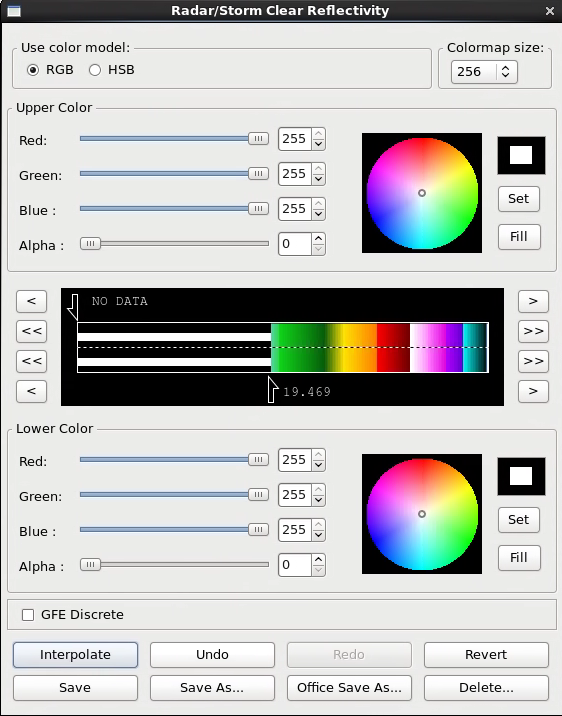
- Left-click on the Interpolate button in the bottom button panel.
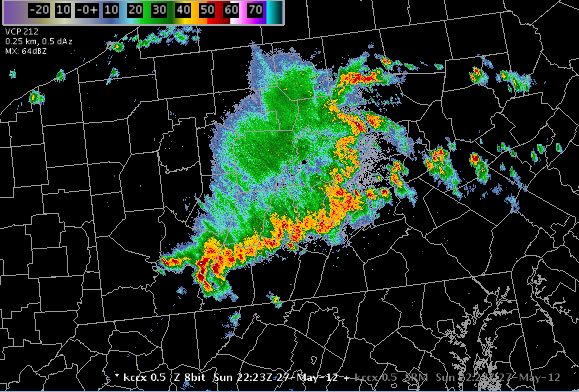
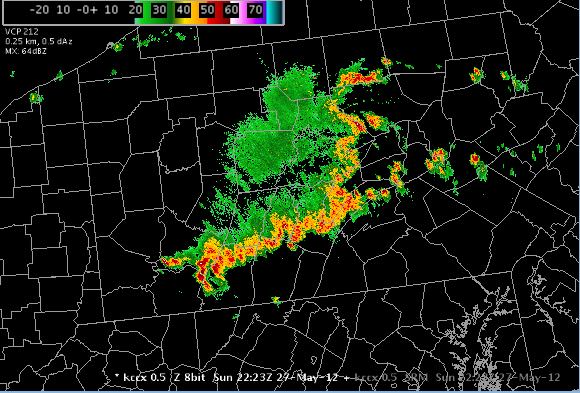
- Undo, Redo, and revert to previously saved colors.
- Left-click on the Undo button to undo the last change to the color table.
- Left-click on the Redo button to reapply the last change made to the color table.
- Left-click on the Revert button to return to the last saved version of the color table.
- Save an edited color table using one of the following methods:
- It is a good practice to save changes to an existing color table to a file once you have made some desired changes.
- It is often preferable to save the changes to a new file, so you can change the new file without negatively impacting any of the existing color tables.
- Method 1: Left-click on the Office Save As button, enter a new name, then left-click the OK button.
- Choose this method if you want the new color table to be available to all users in your office. The change is not applied permanently to the product, so you would have to select it manually if you load a new product.
- Method 2: Left-click on the Save As button, enter a new name, then left-click the OK button.
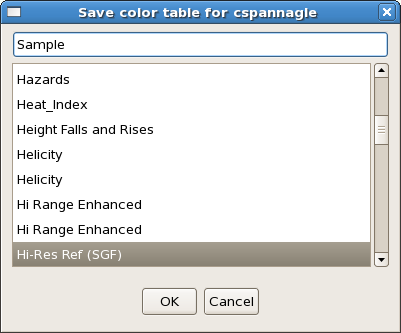
- Choose this method if you want the new color table to only be visible to the current user account. The change is not applied permanently to the product, so you would have to select it manually if you load a new product.
- Method 3: Left-click on the Save button.
- Choose this method if you want to make a user override color table with the same name that is accessible from the USER pullout menu in the color table selector located on the Image Properties window.
- Selecting the Revert button returns the color table to the previous settings, and then you can Save those settings to the product to effectively restore the setting.
- Task Complete!



